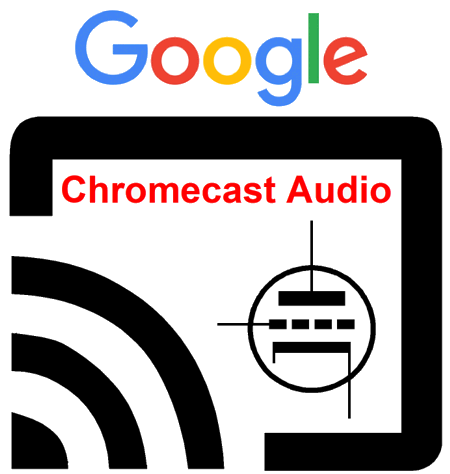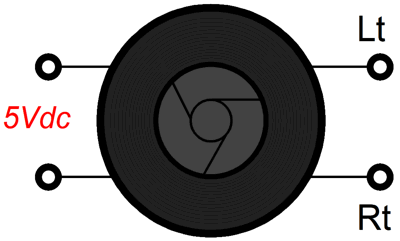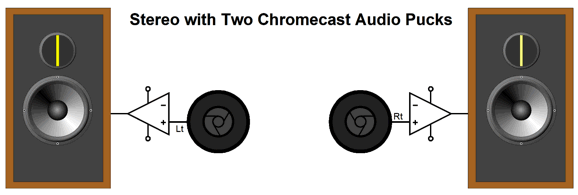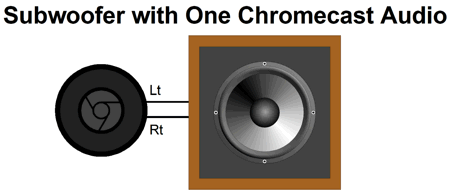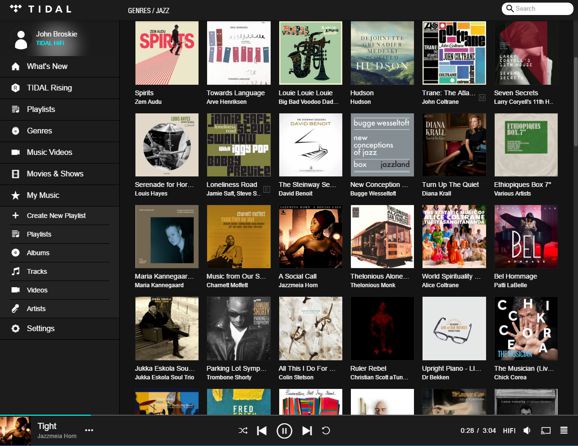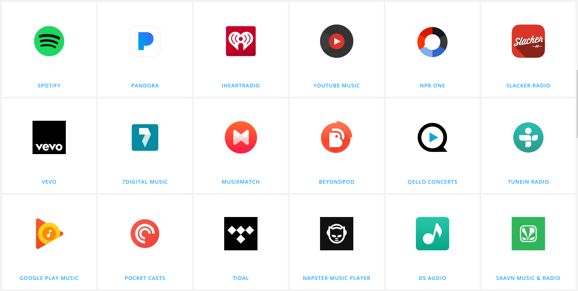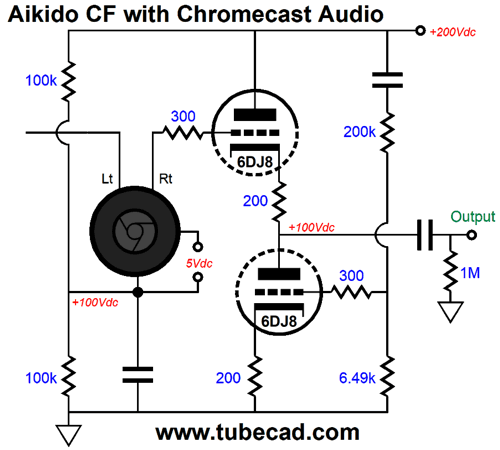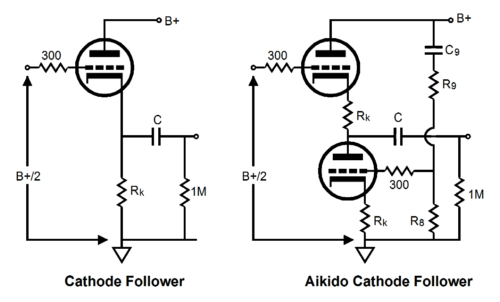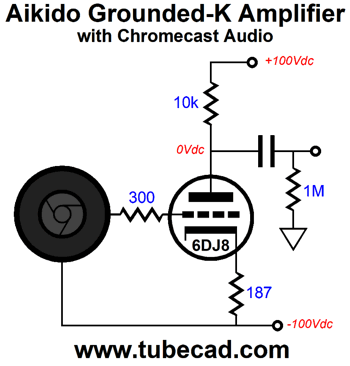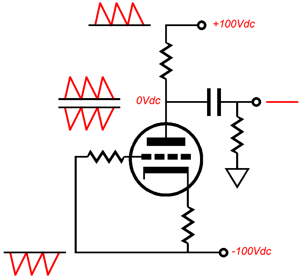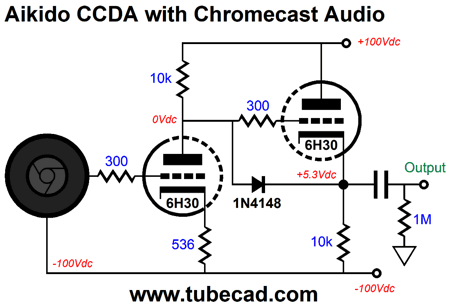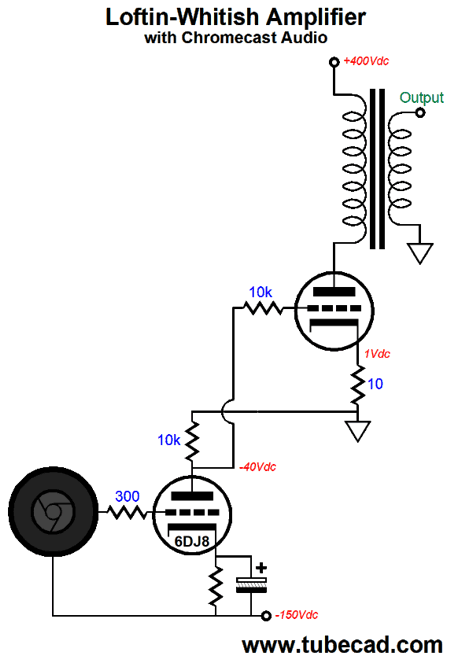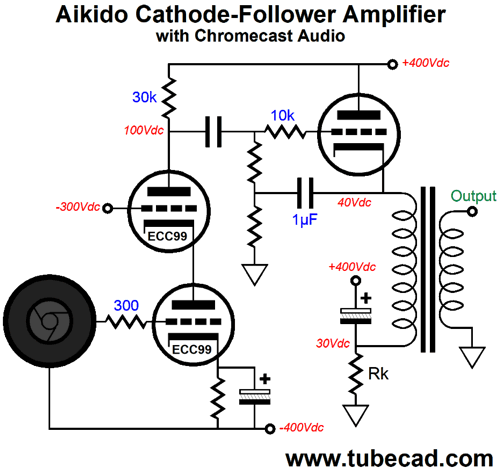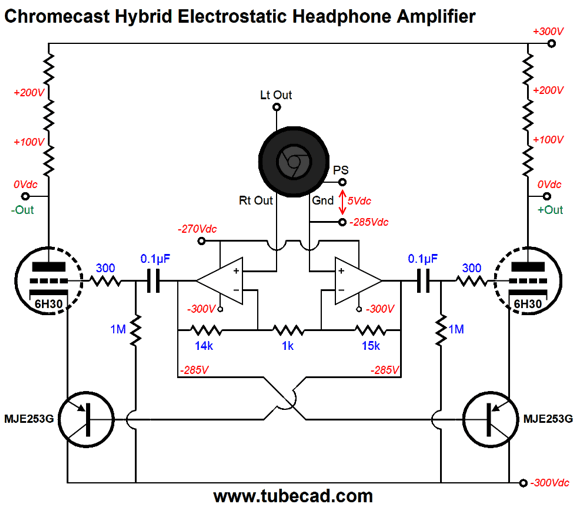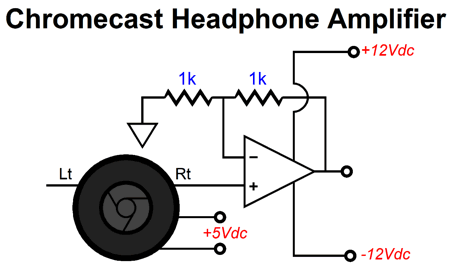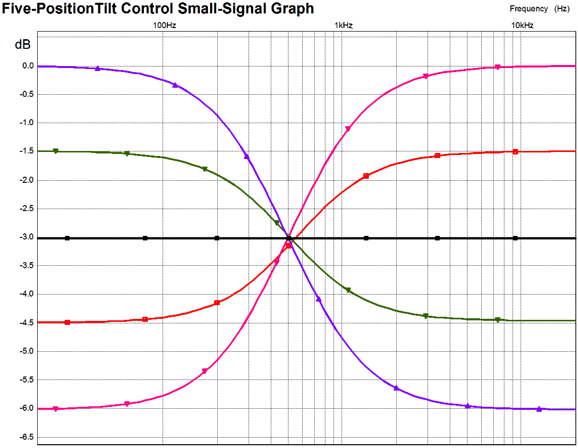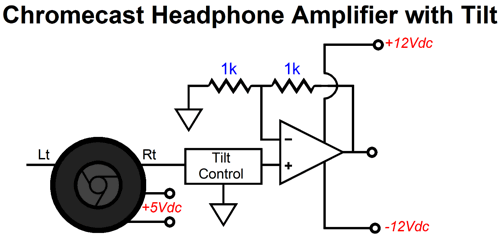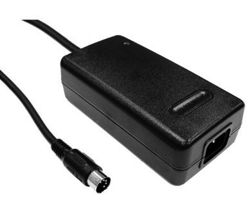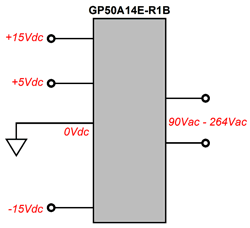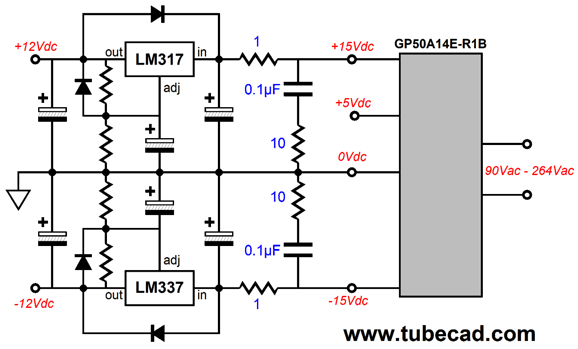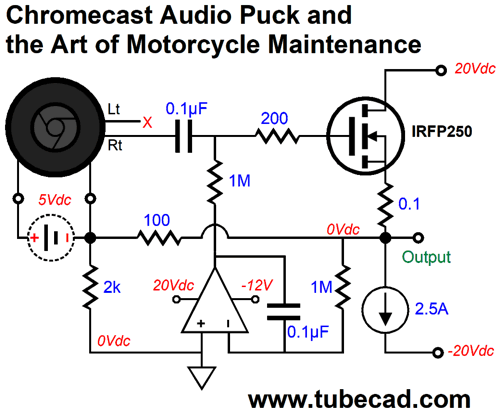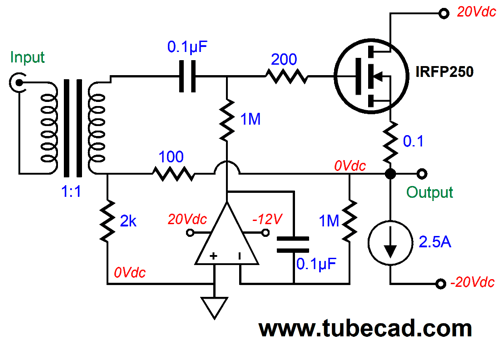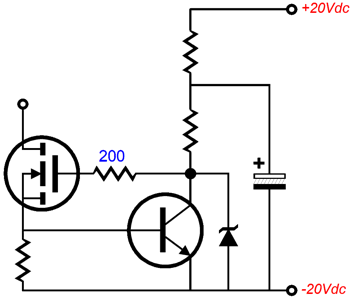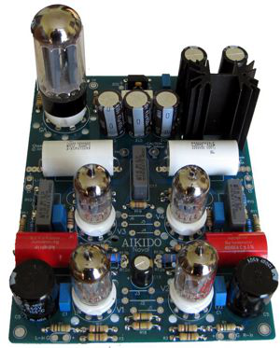| John Broskie's Guide to Tube Circuit Analysis & Design |
18 June 2017 Post Number 384
Chromecast Audio Ideas
Three details stand out, as far as I am concerned. The first is its staggeringly big output voltage of 2.8Vrms, which I cannot believe, as it runs off 5V and 2Vrms equals 2.828Vpk, more than twice half of 5V. My guess is that they mean 2Vrms-pk-pk, which would equal +1.414Vpk to -1.414Vpk. The second specification that stands out is the 96kHz sample rate at 24-bit resolution. This good, not the best, but good. Sending a 24-bit DAC a 16-bit data stream allows for up to -48dB of digital attenuation without signal loss. The last interesting detail is the 1A current draw at 5Vdc. This seemed excessive to me at first, but after I felt how toasty the little puck becomes I now believe it. Indeed, I tried a lower current 5V switcher power supply and the Chromecast Audio balked at the reduced current limit.
Okay, what can we do the Chromecast Audio puck that isn't obvious? If you own mono-block power amplifiers, then you could use two pucks, so that each amplifier gets one. Place an amplifier near its speaker and from the puck feed the input signal to the amplifier. No long runs of either interconnect or speaker cable.
A subtlety that might not be readily seen is that no shared ground exists here. Grounding is a nightmare in most audio systems. With the two pucks, we just sidestepped much of it. But John we only use one channel from each puck; isn't that wasteful? Audiophiles, particularly the extreme audiophiles, tend to be non-linear. The sort of fellow who would voice such an objection is the sort of audiophile who owns $22,000 speaker cables but hates the expense of replacing batteries and hates the thought of using only one half of each $35 puck. I am reminded of my despairing comments I made to buddy of mine after I had listened to the Goldmund ProLogos Wireless loudspeakers and then had heard the $40k price tag. After all, $40,000 will buy two Chromecast Audio pucks with enough money left over to buy a pair of mono-block power amplifiers and a pair of fine loudspeakers, with enough left to put down as down-payment on a house. How do we get the two pucks to play at once. Simple. We make use of the Chromecast multi-room feature, which allows us to make groups of pucks, so that we can cast to a group of pucks.
We could create a group called "Listening Room," which would hold three pucks. Why three? One might be needed for the self-powered subwoofer or headphone amplifier or rear channel amplifiers.
We then use either our phone or a tablet or PC as our control center.
This is quite addicting, as the ease of scanning through your collection of digital music or through some music service, such as Tidal, is a fantastic advance in usability. For example, I like doing a search on my own library for a cover of the Gershwin song "Summertime," and getting over 20 hits; on Tidal, I got close to 500 hits. Plenty of music apps support Chromecasting, such as the following:
Tube-Based Circuits & Chromecasting Here is an example: a DC-coupled Chromecast Audio puck and a tube buffer stage.
The Chromecast Audio puck feeds two channels of audio signal to two Aikido cathode followers. The puck's ground is referenced to +100Vdc, which is safe as the puck's case is made of plastic, not metal. Of course, a generic cathode follower could be used instead.
The Aikido cathode follower, however, offers improved PSRR. If we need more gain, then we can use this Aikido grounded-cathode amplifier, which uses a bipolar power supply to achieve a vastly improved PSRR.
By selecting the right cathode resistor value, we effectively create a two resistance voltage divider, which results in a power-supply ripple null at the output.
If a lower output impedance is needed, we could use a constant-current-draw amplifier stage (CCDA) with a Chromecast Audio puck.
Note how the puck is referenced to -100Vdc. The 1N4148 signal diode is there as a safety device. At startup, when the triodes are cold and not conducting, the right triode would see a +200V voltage differential between its grid and its cathode. Not good. WIt the diode place, the grid can not see any positive differential greater than about 0.7V. Once the triodes are hot, the right triode's cathode will sit +5V above its grid voltage, so the diode is no longer forward biased and it falls out of the circuit. Next, we see a Loftin-White-like amplifier. A bipolar power supply is used and the output tube DC couples to the input stage.
Makes me nervous just to look at it, as I fear what would happen if the input tube were missing from its socket. Coupling capacitors are a pain, but a safe pain. Now that we have mentally warmed up, we can move on to a single-ended cathode-follower output stage.
The Chromecast Audio puck sits at -400Vdc and feeds the bottom ECC99 its input signal. This triode is in cascode with the triode above it, so almost all of the bottom triode's transconductance is preserved, resulting a huge gain at the top plate. Huge signal swings are needed to drive the cathode-follower output stage. The Output tube is cathode biased with the output transformer's own DCR being part of the effective cathode resistor. Note the capacitor that bridges the cathode resistor and the B+ voltage. Why is it there? IS this some Ultrapath mojo? Actually, it's there because the cascode offers almost no PSRR, so all the power-supply ripple leaks out its output. By making the bottom of the primary just as full of ripple as the output tube's grid and plate, we vastly improve the PSRR. Our last tube circuit is an electrostatic headphone amplifier that uses a Chromecast Audio puck as its signal source. (I am sure that when Google created the Chromecast Audio puck, they never dreamed that it could be put to such a use.)
The above design is similar to those from post 382. The puck drives the OpAmp-based phase splitter with gain, which in turn drives the two output triodes and the two PNP transistors, thereby effectively doubling the OpAmps output swing. Yes, its DC and capacitor coupled at the same time.
Chromecast & Solid-State
That's it. We do not need a lot of gain, so the amazing Texas Instruments TPA6120A2 can be used. This OpAmp delivers a slew-rate of 1300V/µS and super low distortion and over 1W of power into a 32-ohm load. (I understand that this chip was originally a video amplifier and that someone hooked to some headphones and was wowed. The dang thing sounds quite, brace yourself, tube-like. How is that the ultimate development in solid-state design results in a sound similar to that delivered sixty years ago by good tube equipment?) We can get fancier, if we wish. For example, we can add one of my Tilt Control, which I find essential for happy headphone listening. With it, I can listen to jazz and rock on my Sennheiser HD650 headphones and classical with my Grado SR225 headphones.
Without it, each is confined to preferred genre.
The power supply must provide bipolar rail voltages to the OpAmp and +5Vdc to the Chromecast Audio puck. One easy solution is use a prepackaged switcher power supply. You can buy a desktop switching power supply with three output voltages: +5V, +15V, and -15V. Jameco sells the Mean Well GP50A14E-R1B $37.49.
The problem with switching power supplies is noise. This switcher puts out 50mVp-p at the 5V output and 150mVp-p on the 15V outputs, which is actually quite good for a switcher. Since we wanted +/-12V rail voltages, we can use the following circuit to provide clean, regulated +/-12V rail voltages.
The 0.1µF capacitors and 10-ohm resistors in series with each other allow the high-frequency hash to turn into heat, while the 1-ohm resistors form an RC filter with the large-valued electrolytic capacitors, which pre-filter the DC entering the linear regulators. Okay, now the easy obvious stuff is out of the way, let's fasten our mental seatbelts and prepare for a wild ride. The following amplifier requires one puck per channel.
Nelson Pass famously asked what was the sound of one MOSFET driving a speaker. Well, this is one possible answer. Very Zen. The IRFP250 with its 0.1-ohm source resistor exhibits a transconductance of about 10A/V, so 1V of input signal would result in 10A of current swing, which into an 8-ohm load would equal 80V. By attaching the Chromecast Audio puck to a two-resistor voltage divider, however, we limit the gain to about 12, so the Chromecast Audio puck can drive the MOSFET to deliver 2A into the 8-ohm load, which equals 16W of power, single-ended, class-A power mind you. Unlike the previous design, this Chromecast Audio puck requires its own floating 5V power supply, as it will bounce up and down with the output signal. The OpAmp works as a DC servo to eliminate any DC offset. The 2.5A constant-current source can be made up from another IRFP250 MOSFET. If this circuit makes no sense to you, try this one instead.
The input signal transformer offers a winding ratio of 1:1, yet this amplifier delivers gain due the transformer's secondary being partially terminated into the amplifier's output. If the transformer had terminated into ground, no gain would obtain; if terminated 100% into the output, too much gain would result.
Now, 2.5A of current flow against 20Vdc equals 50W of heat, which is plenty hot. In fact, so hot that forced cooling might be required. The workaround is either a lower idle current flow or lower power-supply rail voltages or several MOSFETs in parallel.
Next Time
//JRB
Patreon My second goal is to gather 1,000 patrons, which may seem a crazy goal, but then the world is a big place. I have 960 patrons to go. If you enjoyed reading this post from me, then you might consider becoming one of my patrons at Patreon.com.
User Guides for GlassWare Software
For those of you who still have old computers running Windows XP (32-bit) or any other Windows 32-bit OS, I have setup the download availability of my old old standards: Tube CAD, SE Amp CAD, and Audio Gadgets. The downloads are at the GlassWare-Yahoo store and the price is only $9.95 for each program. http://glass-ware.stores.yahoo.net/adsoffromgla.html So many have asked that I had to do it. WARNING: THESE THREE PROGRAMS WILL NOT RUN UNDER VISTA 64-Bit or WINDOWS 7 & 8 or any other 64-bit OS. I do plan on remaking all of these programs into 64-bit versions, but it will be a huge ordeal, as programming requires vast chunks of noise-free time, something very rare with children running about. Ideally, I would love to come out with versions that run on iPads and Android-OS tablets. //JRB |
E-mail from GlassWare Customers
High-quality, double-sided, extra thick, 2-oz traces, plated-through holes, dual sets of resistor pads and pads for two coupling capacitors. Stereo and mono, octal and 9-pin printed circuit boards available. http://glass-ware.stores.yahoo.net/ Support the Tube CAD Journal & get an extremely powerful push-pull tube-amplifier simulator for TCJ Push-Pull Calculator
TCJ PPC Version 2 Improvements Rebuilt simulation engine *User definable
Download or CD ROM For more information, please visit our Web site : To purchase, please visit our Yahoo Store: |
|||
| www.tubecad.com Copyright © 1999-2017 GlassWare All Rights Reserved |
